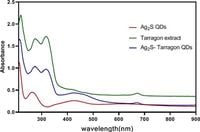Researchers have made significant advancements in the field of nanotechnology, specifically through the innovative synthesis of silver sulfide quantum dots (Ag2S QDs) using a natural plant extract. This process, which employs Artemisia dracunculus, commonly known as tarragon, for green synthesis, marks a promising step towards biocompatible nanoparticles suitable for medical applications in drug delivery and imaging.
The study, published in Scientific Reports on March 25, 2025, emphasizes the unique properties of quantum dots, particularly their size-dependent luminescence that can be harnessed for various biomedical purposes. The researchers demonstrated that the Ag2S QDs produced via tarragon extract had a mean diameter of 56 nm, a reduction in zeta potential from -13 eV to -21 eV, indicative of enhanced colloidal stability. This stability is crucial for their effective circulation within biological systems.
Furthermore, the hemolysis tests indicated that QDs synthesized with tarragon extract exhibited significantly lower toxicity levels, reflecting a reduction in the lysis of red blood cells. Cell viability studies corroborated these findings, displaying increased cell survival rates when human fibroblast cells (HFF-2) were exposed to the tarragon-coated quantum dots compared to conventional chemically synthesized Ag2S QDs.
The traditional methods of synthesizing quantum dots often involve hazardous chemicals and complex procedures. However, this green synthesis technique aligns with sustainable practices by minimizing environmental impact and reliance on toxic materials. Additionally, utilizing natural sources like tarragon not only facilitates a less toxic production process but also enhances the biocompatibility of the nanoparticles, making them more applicable in clinical settings.
Quantum dots, due to their remarkable optical and electronic properties, have gained immense attention in scientific research over the past decade. The silver sulfide variant, in particular, has become a focus of interest due to its potential in photodynamic therapy and imaging applications. This study underscores that by altering the synthesis environment—specifically, using naturally derived materials—researchers can significantly improve the performance and safety profiles of nanoscale materials.
The results indicate that this green synthesis approach could pave the way for environmentally friendly production techniques in nanotechnology. The ability to reduce the toxicity of quantum dots while maintaining their functional properties is a breakthrough that may see them become integral components of future medical therapies.
Looking forward, the authors call for further research to validate the findings across various cell types and conditions, which could lead to broader applications of Ag2S QDs in clinical practices. The evidence suggests that utilizing Artemisia dracunculus in nanoparticle synthesis not only benefits the environment but also enhances drug delivery systems' efficacy.
This remarkable development in the synthesis of Ag2S QDs unveils a sustainable alternative to traditional methods, promoting ecological safety and providing a robust platform for advancing nanotechnological applications in medicine. The implications of this research could resonate through both pharmaceutical and environmental sectors, heralding a new era in how nanoparticles are produced and utilized.

